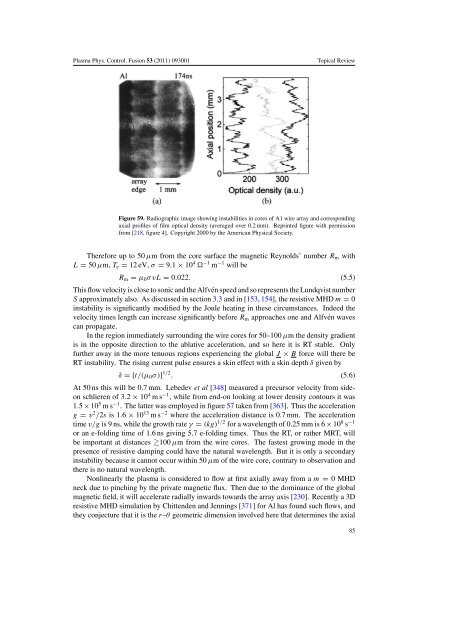Create successful ePaper yourself
Turn your PDF publications into a flip-book with our unique Google optimized e-Paper software.
Plasma Phys. Control. Fusion 53 (2011) 093001<br />
Topical Review<br />
Figure 59. Radiographic image showing instabilities in cores <strong>of</strong> A1 wire array and corresponding<br />
axial pr<strong>of</strong>iles <strong>of</strong> film optical density (averaged over 0.2 mm). Reprinted figure with permission<br />
from [218, figure 4]. Copyright 2000 by <strong>the</strong> American Physical Society.<br />
Therefore up to 50 µm from <strong>the</strong> core surface <strong>the</strong> magnetic Reynolds’ number R m with<br />
L = 50 µm, T e = 12 eV, σ = 9.1 × 10 4 −1 m −1 will be<br />
R m = µ 0 σvL = 0.022. (5.5)<br />
This flow velocity is close to sonic and <strong>the</strong> Alfvén speed and so represents <strong>the</strong> Lundqvist number<br />
S approximately also. As discussed in section 3.3 and in [153, 154], <strong>the</strong> resistive MHD m = 0<br />
instability is significantly modified by <strong>the</strong> Joule heating in <strong>the</strong>se circumstances. Indeed <strong>the</strong><br />
velocity times length can increase significantly before R m approaches one and Alfvén waves<br />
can propagate.<br />
In <strong>the</strong> region immediately surrounding <strong>the</strong> wire cores for 50–100 µm <strong>the</strong> density gradient<br />
is in <strong>the</strong> opposite direction to <strong>the</strong> ablative acceleration, and so here it is RT stable. Only<br />
fur<strong>the</strong>r away in <strong>the</strong> more tenuous regions experiencing <strong>the</strong> global J × B force will <strong>the</strong>re be<br />
RT instability. The rising current pulse ensures a skin effect with a skin depth δ given by<br />
δ = [t/(µ 0 σ)] 1/2 . (5.6)<br />
At 50 ns this will be 0.7 mm. Lebedev et al [348] measured a precursor velocity from sideon<br />
schlieren <strong>of</strong> 3.2 × 10 4 ms −1 , while from end-on looking at lower density contours it was<br />
1.5 × 10 5 ms −1 . The latter was employed in figure 57 taken from [363]. Thus <strong>the</strong> acceleration<br />
g = v 2 /2s is 1.6 × 10 13 ms −2 where <strong>the</strong> acceleration distance is 0.7 mm. The acceleration<br />
time v/g is 9 ns, while <strong>the</strong> growth rate γ = (kg) 1/2 for a wavelength <strong>of</strong> 0.25 mm is 6 × 10 8 s −1<br />
or an e-folding time <strong>of</strong> 1.6 ns giving 5.7 e-folding times. Thus <strong>the</strong> RT, or ra<strong>the</strong>r MRT, will<br />
be important at distances 100 µm from <strong>the</strong> wire cores. The fastest growing mode in <strong>the</strong><br />
presence <strong>of</strong> resistive damping could have <strong>the</strong> natural wavelength. But it is only a secondary<br />
instability because it cannot occur within 50 µm <strong>of</strong> <strong>the</strong> wire core, contrary to observation and<br />
<strong>the</strong>re is no natural wavelength.<br />
Nonlinearly <strong>the</strong> plasma is considered to flow at first axially away from a m = 0 MHD<br />
neck due to <strong>pinch</strong>ing by <strong>the</strong> private magnetic flux. Then due to <strong>the</strong> dominance <strong>of</strong> <strong>the</strong> global<br />
magnetic field, it will accelerate radially inwards towards <strong>the</strong> array axis [230]. Recently a 3D<br />
resistive MHD simulation by Chittenden and Jennings [371] for Al has found such flows, and<br />
<strong>the</strong>y conjecture that it is <strong>the</strong> r–θ geometric dimension involved here that determines <strong>the</strong> axial<br />
85














